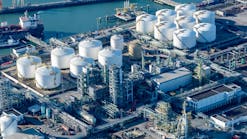Chinese operator lets contract for Shangdong integrated refining complex
Shandong Yulong Petrochemical Co. Ltd.—a joint venture of China’s Nanshan Holdings Co. Ltd. (71%), Wanhua Chemical Group Co. Ltd. (20%), and Shandong Development & Investment Holding Group Co. Ltd. (9%)—has let a contract to Lummus Technology LLC to provide technology licensing for units at Shandong Yulong’s grassroots 20-million tonnes/year integrated refining and petrochemical complex under construction as part of the first phase of the Yulong Island Refining and Chemical Integrating Project at Yulong Petrochemical Industrial Park, Yantai City, Shandong Province, China.
Lummus will deliver licensing for its proprietary technologies to be implemented at the complex’s two mixed-feed crackers, an ethylbenzene-styrene monomer (EB-SM) plant, and two polypropylene (PP) plants, the service provider said.
Alongside technology licensing, Lummus will provide basic engineering-process design packages, advisory services, training, master-licensor integration services, as well as catalyst supply for the two PP lines.
While Lummus disclosed neither a value of the contract nor capacities of the units involved in the agreement, official project documents from China’s Ministry of Ecology and Environment (MEE) revealed:
- The mixed-feed crackers of the complex’s two ethylene plants—each with a capacity of 1.5 million tpy—will use Lummus’s highly selective Short Residence Time (SRT) VII cracking heaters.
- The 500,000-tpy EB-SM plant will be equipped with Lummus-UOP LLC’s EBOne and CLASSIC SM technologies.
- The two 400,000-tpy PP lines will use Lummus Novolen Technology GMBH’s proprietary Novolen gas-phase PP technology.
Complex overview
According to MEE, the nearly 127.4-billion Yulong Island Refining and Chemical Integrating Project (Phase 1)—which, after gaining formal approval earlier this year, began construction in late October—will include the following major units and available planned capacities:
- One 10-million tpy atmospheric distillation unit.
- One 10-million tpy combined atmospheric-vacuum distillation unit.
- Two light hydrocarbon recovery units.
- One 2.6-million tpy slurry bed residue hydrogenation unit.
- One 1.2-million tpy solvent deasphalting unit.
- One 100,000-cu m/hr residual oil hydrogen production unit.
- Three 2.6-million tpy residual oil hydrotreating units.
- One 1.5-million tpy wax oil hydrotreating unit.
- One 2-million tpy wax oil hydrocracking unit.
- One 500,000-tpy heavy oil, high-pressure hydrogenation unit.
- One 3.4-million tpy diesel hydrotreating unit.
- One 3.6-million tpy diesel hydrocracking unit.
- One 1.4-million tpy kerosene hydrogenation unit.
- One grassroots hydrogen centralized supply station.
- One 4-million tpy catalytic cracking unit.
- One 1.6-million tpy gas fractionation unit.
- One 1-million tpy pyrolysis gasoline hydrogenation unit.
- One 800,000-tpy aromatic extraction unit.
- One 3-million tpy catalytic cracking unit.
- One 700,000-tpy gas fractionation unit.
- One 1.5-million tpy catalytic gasoline adsorption desulfurization (S-Zorb) unit.
- Two 2.6-million tpy continuous reforming units.
- One 3-million tpy aromatics combined plant.
- One 220,000-cu m/hr coal hydrogen production unit.
- Four 150,000-tpy sulfur recovery and tail gas treatment units.
- One sour water stripping unit.
- One solvent regeneration unit.
- Two 1.5-million tpy ethylene plants.
- Two 85-million tpy pyrolysis gasoline hydrogenation units.
- Two 550,000-tpy aromatics extraction units.
- Two 220,000-tpy butadiene extraction units.
- One 500,000-tpy EB-SM plant.
- Two 800,000-tpy ethylene glycol plants.
- Two 400,000-tpy PP plants (Lummus Novolen-licensed).
- Two 400,000-tpy PP plant (separate from Novolen-licensed units).
- One 300,000-tpy PP plant (Japan Polypropylene Corp.-licensed HORIZONE process)
- One 200,000-tpy low-density polyethylene-ethylene vinyl acetate LDPE-EVA unit.
- One 400,000-tpy LDPE-EVA unit.
- One 300,000-tpy high-density polyethylene (HDPE) unit.
Phase 1 of the development is scheduled to begin operation in 2022-23.

Robert Brelsford | Downstream Editor
Robert Brelsford joined Oil & Gas Journal in October 2013 as downstream technology editor after 8 years as a crude oil price and news reporter on spot crude transactions at the US Gulf Coast, West Coast, Canadian, and Latin American markets. He holds a BA (2000) in English from Rice University and an MS (2003) in education and social policy from Northwestern University.

